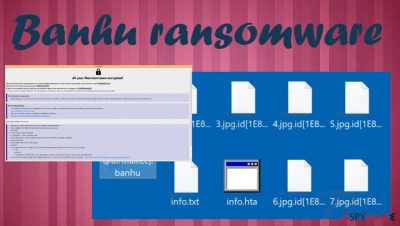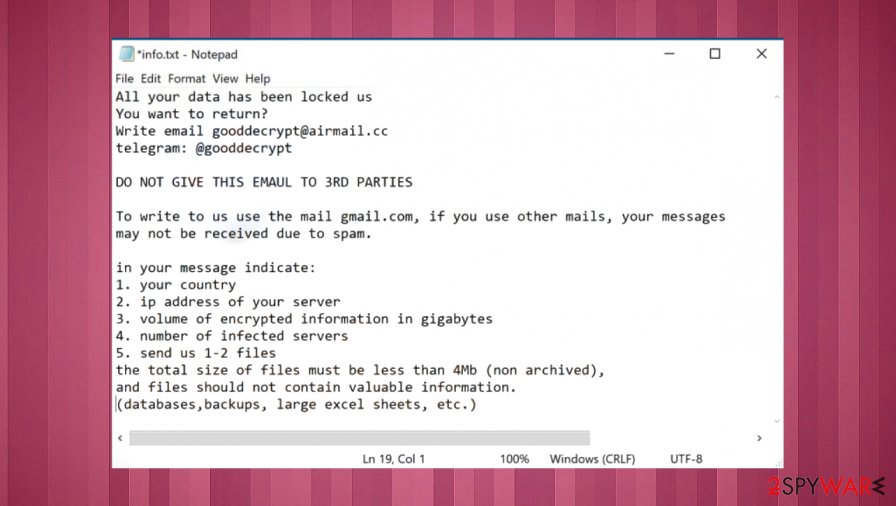Banhu ransomware (Free Guide) - Removal Instructions
Banhu virus Removal Guide
What is Banhu ransomware?
Banhu ransomware is a threat that stems from Phobos cryptovirus family

Banhu ransomware is a malicious program designed to encrypt all personal data on the computer and then demand ransom for its return. Once inside the system, it encrypts all personal pictures, videos, documents, archives, and other files by using a strong encryption algorithm,[1] which also appends a .banhu extension in the process. Victims can no longer access these files, and criminals require payment for the unique key which is needed for the recovery of files.
Once the encryption is complete, Banhu ransomware virus drops a ransom note info.txt and info.hta instructions for further actions. These files explain to victims what happened to their files and claim that the only method to return them is by paying a ransom for a decryption tool. For negotiation purposes, crooks also provide contact – gooddecrypt@airmail.cc, @gooddecrypt Telegram.
Banhu ransomware is a cryptovirus that belongs to a malware family known as Phobos. Such type of malware encrypts all the important files on a Windows computer that you commonly use. Other data in system folders get affected differently, so you cannot use the machine properly. Cybercriminals explain that the only way to recover data is by paying ransom in Bitcoin, but it is not recommended. Experts[2] recommend removing the virus instead. Then you can try to recover data using backups.
| Name | Banhu ransomware |
|---|---|
| Type | Ransomware, file locking virus |
| Malware family | Phobos |
| Extension | Files appended with a full .[gooddecrypt@airmail.cc].banhu extension that also includes victims' ID at the beginning. The lengthy appendix appears on every affected file |
| Ransom note | Info.txt and info.hta |
| Distribution | File attachments form emails and malicious sites spread the payload of ransomware |
| Contact | gooddecrypt@airmail.cc, @gooddecrypt Telegram. |
| File recovery | If no backups are available, recovering data is almost impossible. There is no decryption tool for this virus. Nonetheless, we suggest you try the alternative methods that could help you in some cases – we list them below |
| Malware removal | Perform a full system scan with powerful security software to remove Banhu ransomware |
| System fix | Malware can seriously tamper with Windows systems, causing errors, and other stability issues after it is terminated. We recommend scanning it with the FortectIntego tool for damage fix |
Once inside, Banhu ransomware uses an encryption algorithm to lock up all documents, archives, videos, music, and other files, adding .banhu extension to them. This is the indication that the machine is infected and needs proper recovery of the functions.
According to Banhu virus authors, victims need to contact them to get their personal ID. Once that is done, users should receive further instructions to proceed with the payment, provided in bitcoin cryptocurrency. Nonetheless, we do not recommend contacting the attackers because they might not deliver the required decryption tool.
None of the previous versions in this Phobos family got decrypted yet. This is the newest version that came out at the end of 2020, but there are tons of them out there and possibly still active like .google, 1500dollars, MONETA, HOTEL. Do not panic and do not consider the payment as an option.
Check out the alternative methods we provide below instead and remove Banhu ransomware from the machine using tools like SpyHunter 5Combo Cleaner or Malwarebytes that are designed to clear infections and malware. Only then your device can get recovered and data restored.

Ransomware is a type of virus that is classified as a cryptocurrency extortion-based virus. These threats are known for accessing user machines without permission and encrypting all files on them. This way, cybercriminals behind the attack can ask for a ransom payment in return for a unique key.
In the ransom note, the attackers write that they are willing to provide the decryption tool for a particular sum of money, to be paid in Bitcoin cryptocurrency. They also provide further instructions:
All your files have been encrypted!
All your files have been encrypted due to a security problem with your PC. If you want to restore them, write us to the e-mail gooddecrypt@airmail.cc
Write this ID in the title of your message 1E857D00-2422
Our operator is available in the messenger Telegram: @gooddecrypt
DO NOT GIVE THIS EMAUL TO 3RD PARTIES
To write to us use the mail gmail.com, if you use other mails, your messages may not be received due to spam.
in your message indicate:
1. your country
2. ip address of your server
3. volume of encrypted information in gigabytes
4. number of infected servers
5. send us 1-2 files
the total size of files must be less than 4Mb (non archived), and files should not contain valuable information. (databases,backups, large excel sheets, etc.)
How to obtain Bitcoins
The easiest way to buy bitcoins is LocalBitcoins site. You have to register, click 'Buy bitcoins', and select the seller by payment method and price.
hxxps://localbitcoins.com/buy_bitcoins
Also you can find other places to buy Bitcoins and beginners guide here:
hxxp://www.coindesk.com/information/how-can-i-buy-bitcoins/
Attention!
Do not rename encrypted files.
Do not try to decrypt your data using third party software, it may cause permanent data loss.
Decryption of your files with the help of third parties may cause increased price (they add their fee to our) or you can become a victim of a scam.
Banhu file virus decryption is not the same as removing the ransomware
Even though the creators of the Banhu virus try to convince people that transferring cryptocurrency is the only solution, you should ignore those scary messages and make sure to recover the machine after the attack. There are particular parts of the system that malware affects directly, but other issues regarding the infection can be found deep inside the OS.

Banhu ransomware removal is required and can be achieved with security tools that detect[3] this intruder and can properly eliminate any associated files. However, additional issues triggered on your device and affecting performance, programs, functions require applications like FortectIntego. These tools can find and fix issues with system functionality. Only then you can follow with data recovery and system restoring procedures.
Remember that Banhu file virus can affect various parts of the OS to ensure the persistence and difficult file recovery procedures. You should rely on security tools and remove the virus properly. Double-check before going for any data recovery options or adding a data backup device to the PC.
You need to have a virus-free machine before you can go for any file restoring options. Otherwise, you risk getting your files encrypted again or damaged permanently.
Banhu ransomware virus removal procedure includes PC repair
The procedure that allows this virus to come to your device is difficult but silent and dangerous. The threat is also complicated to terminate because virus creators run additional processes, so the user cannot easily remove Banhu ransomware themselves. This is why researchers recommend using SpyHunter 5Combo Cleaner or Malwarebytes for the main job.
Banhu ransomware removal is not easy as it is not easy to recover files after the virus interference. You need to rely on security tools and proper anti-malware programs that can eliminate this or any additional cyber threats affecting your time on the PC. Running a FortectIntego or similar applications helps delete the remaining damage and fix file damage in system folders. Then you can rely on data backups or third-party options and recover encoded files.
Getting rid of Banhu virus. Follow these steps
Manual removal using Safe Mode
Reboot the device in Safe Mode with Networking and remove .banhu virus
Important! →
Manual removal guide might be too complicated for regular computer users. It requires advanced IT knowledge to be performed correctly (if vital system files are removed or damaged, it might result in full Windows compromise), and it also might take hours to complete. Therefore, we highly advise using the automatic method provided above instead.
Step 1. Access Safe Mode with Networking
Manual malware removal should be best performed in the Safe Mode environment.
Windows 7 / Vista / XP
- Click Start > Shutdown > Restart > OK.
- When your computer becomes active, start pressing F8 button (if that does not work, try F2, F12, Del, etc. – it all depends on your motherboard model) multiple times until you see the Advanced Boot Options window.
- Select Safe Mode with Networking from the list.

Windows 10 / Windows 8
- Right-click on Start button and select Settings.

- Scroll down to pick Update & Security.

- On the left side of the window, pick Recovery.
- Now scroll down to find Advanced Startup section.
- Click Restart now.

- Select Troubleshoot.

- Go to Advanced options.

- Select Startup Settings.

- Press Restart.
- Now press 5 or click 5) Enable Safe Mode with Networking.

Step 2. Shut down suspicious processes
Windows Task Manager is a useful tool that shows all the processes running in the background. If malware is running a process, you need to shut it down:
- Press Ctrl + Shift + Esc on your keyboard to open Windows Task Manager.
- Click on More details.

- Scroll down to Background processes section, and look for anything suspicious.
- Right-click and select Open file location.

- Go back to the process, right-click and pick End Task.

- Delete the contents of the malicious folder.
Step 3. Check program Startup
- Press Ctrl + Shift + Esc on your keyboard to open Windows Task Manager.
- Go to Startup tab.
- Right-click on the suspicious program and pick Disable.

Step 4. Delete virus files
Malware-related files can be found in various places within your computer. Here are instructions that could help you find them:
- Type in Disk Cleanup in Windows search and press Enter.

- Select the drive you want to clean (C: is your main drive by default and is likely to be the one that has malicious files in).
- Scroll through the Files to delete list and select the following:
Temporary Internet Files
Downloads
Recycle Bin
Temporary files - Pick Clean up system files.

- You can also look for other malicious files hidden in the following folders (type these entries in Windows Search and press Enter):
%AppData%
%LocalAppData%
%ProgramData%
%WinDir%
After you are finished, reboot the PC in normal mode.
Remove Banhu using System Restore
System Restore is the function helping to recover after the infection
-
Step 1: Reboot your computer to Safe Mode with Command Prompt
Windows 7 / Vista / XP- Click Start → Shutdown → Restart → OK.
- When your computer becomes active, start pressing F8 multiple times until you see the Advanced Boot Options window.
-
Select Command Prompt from the list

Windows 10 / Windows 8- Press the Power button at the Windows login screen. Now press and hold Shift, which is on your keyboard, and click Restart..
- Now select Troubleshoot → Advanced options → Startup Settings and finally press Restart.
-
Once your computer becomes active, select Enable Safe Mode with Command Prompt in Startup Settings window.

-
Step 2: Restore your system files and settings
-
Once the Command Prompt window shows up, enter cd restore and click Enter.

-
Now type rstrui.exe and press Enter again..

-
When a new window shows up, click Next and select your restore point that is prior the infiltration of Banhu. After doing that, click Next.


-
Now click Yes to start system restore.

-
Once the Command Prompt window shows up, enter cd restore and click Enter.
Bonus: Recover your data
Guide which is presented above is supposed to help you remove Banhu from your computer. To recover your encrypted files, we recommend using a detailed guide prepared by 2-spyware.com security experts.If your files are encrypted by Banhu, you can use several methods to restore them:
Try Data Recovery Pro Method
The way to restore encrypted files – Data Recovery Pro
- Download Data Recovery Pro;
- Follow the steps of Data Recovery Setup and install the program on your computer;
- Launch it and scan your computer for files encrypted by Banhu ransomware;
- Restore them.
Windows Previous Versions feature allows to recover .banhu appended files
When System Restore gets enabled, you can rely on Windows Previous Versions
- Find an encrypted file you need to restore and right-click on it;
- Select “Properties” and go to “Previous versions” tab;
- Here, check each of available copies of the file in “Folder versions”. You should select the version you want to recover and click “Restore”.
ShadowExplorer – way to restore files after ransomware attack
Try to recover data when Shadow Volume Copies are not deleted
- Download Shadow Explorer (http://shadowexplorer.com/);
- Follow a Shadow Explorer Setup Wizard and install this application on your computer;
- Launch the program and go through the drop down menu on the top left corner to select the disk of your encrypted data. Check what folders are there;
- Right-click on the folder you want to restore and select “Export”. You can also select where you want it to be stored.
Decryption is not possible for this version
Finally, you should always think about the protection of crypto-ransomwares. In order to protect your computer from Banhu and other ransomwares, use a reputable anti-spyware, such as FortectIntego, SpyHunter 5Combo Cleaner or Malwarebytes
How to prevent from getting ransomware
Stream videos without limitations, no matter where you are
There are multiple parties that could find out almost anything about you by checking your online activity. While this is highly unlikely, advertisers and tech companies are constantly tracking you online. The first step to privacy should be a secure browser that focuses on tracker reduction to a minimum.
Even if you employ a secure browser, you will not be able to access websites that are restricted due to local government laws or other reasons. In other words, you may not be able to stream Disney+ or US-based Netflix in some countries. To bypass these restrictions, you can employ a powerful Private Internet Access VPN, which provides dedicated servers for torrenting and streaming, not slowing you down in the process.
Data backups are important – recover your lost files
Ransomware is one of the biggest threats to personal data. Once it is executed on a machine, it launches a sophisticated encryption algorithm that locks all your files, although it does not destroy them. The most common misconception is that anti-malware software can return files to their previous states. This is not true, however, and data remains locked after the malicious payload is deleted.
While regular data backups are the only secure method to recover your files after a ransomware attack, tools such as Data Recovery Pro can also be effective and restore at least some of your lost data.
- ^ Encryption. Wikipedia. The free encyclopedia.
- ^ Avirus. Avirus. Spyware related news.
- ^ Detection rate. VirusTotal. Online malware tool.





















